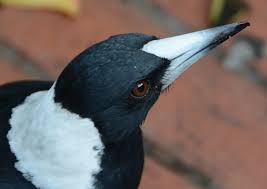 I loved this program when it was first broadcast a few months ago and appreciated the ABC’s Radio National “re-releasing” it as a podcast. I always love watching magpies and so often notice fascinating behaviours. For some years many times I went outside to hang the washing out the same magpie would fly down and perch on the clothes line, looking intently at me as if to greet me and spend some time with me. In Australia we easily take their beautiful song for granted so I was pulled up with some surprise when an overseas tourist expressed amazement at the sound.
I loved this program when it was first broadcast a few months ago and appreciated the ABC’s Radio National “re-releasing” it as a podcast. I always love watching magpies and so often notice fascinating behaviours. For some years many times I went outside to hang the washing out the same magpie would fly down and perch on the clothes line, looking intently at me as if to greet me and spend some time with me. In Australia we easily take their beautiful song for granted so I was pulled up with some surprise when an overseas tourist expressed amazement at the sound.
Anyone interested who hasn’t yet heard the program, do listen to
The colourful life of the Australian Magpie
The opening seconds is all you need to hear their sound.
Other details that fascinated me:
- they are listening for the sounds of grubs etc beneath the grass
- they recognize individual human faces
- in the event of the loss of the male partner the female soon accepts another male replacement who continues to care and provide for her chicks
- their black and white colour is no camouflage but functions as a highly visual signal for territorial purposes
If you enjoyed this post, please consider donating to Vridar. Thanks!

They can be nasty when they attack people particularly cyclists. More than once they have drawn blood from my head. Some even go for the eyes.
Best avoided August-November!
I was interested to learn that it’s only a small fraction of the magpie population who attack, but yes, they can be vicious. I had much more difficulty with our beautiful golden plovers in my last place of residence. A plover even used the barb tip on its wing to cut the neck of a work colleague. Well, what do we expect from the descendants of dinosaurs.
The maggie was looking for a bite?
When I feed the deranged, raucous, trumped up budgies (i.e. Sulphur crested, Galahs, Long-billed and little Correllas of the cockatoo family), the maggies fly over to see if I have something for them.
Instead of throwing out left-overs or scraps, I give it to the maggies for a meal.
My clothes line maggie was perfectly refined and looking for nothing more than a bit of intelligent conversation. I would speak to it and it loved to listen and respond with knowing body-language. I never fed any birds in my yard — apart from worms and nectar they found in the ground and trees.
I feed the cockatoos because some of them have beak and feather disease and their beaks are deformed and feathers falling out. If we do nothing, they’ll infect lots of other cockatoos and die a slow, painful death. When we catch the odd sick one, it’s euthanized by a vet, so its suffering is reduced, and there’s less of a disease reservoir (I hope). The maggies just show up to see if there’s anything for them. We throw some scraps, and they sing for us. Most of their diet comes from foraging.
Over the many years we lived in city suburbs we encountered numerous examples of ‘swooping’ magpies who presented a ‘clear and present danger’ to anyone in the vicinity.
Now we live on a rural property with at least one resident magpie family who completely ignore both us and our dogs.
The difference, I suspect, is that here there is an abundance of eminently suitable breeding sites and similarly plentiful food supply and therefore we, dogs included, present no threat to the birds.
But other birds do – other magpies and other species whose feeding and breeding habits are perceived as threats. So we witness daily the establishing and maintaining of territories by those that share our land. Every day someone is having a go at someone else – magpies against currawongs, currawongs against ravens, either against kookaburras, everybody has a go at the butcherbirds and all panic when the peregrines are around. And the willie wagtail, smallest of the lot but ounce for ounce by far the most aggressive taking on anyone at all up to and including eagles – totally fearless.
There are so many invisible lines drawn in the sky and on the ground and around the trees at this place and we sit back in the centre of squabbles, forays and wars in blissful peace watching and listening to them all. Never a dull moment.
And they all loathe the parrots. I’ve seen a single cockatoo fly into a tree at roosting time and immediately scores of birds already settled there all fly out en mass to look for a new place for the evening. It’s like the parrots are the untermensch, the “wogs” of the bird world.
Like this damned annoying little bugger . . . .
(Taken last month at Augathella on a long drive from Darwin to Brisbane.)
It wouldn’t surprise me to find that magpies do many things for the mere thrill of it.